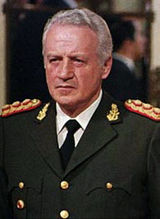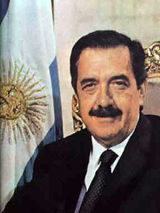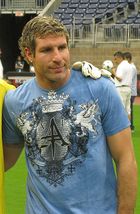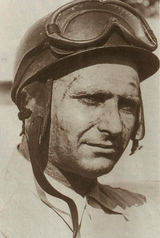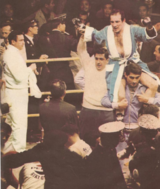White Argentine: Difference between revisions
imported>Pablo Martín Zampini |
imported>Pablo Martín Zampini |
||
| Line 223: | Line 223: | ||
Given that the main sources of South American immigrants since the 1960s have been [[Bolivia]], [[Paraguay]] and [[Perú]], most of these immigrants have been either [[Amerindian]] or [[Mestizo]], for these groups represent the ethnic majorities in their countries of origin.<ref name="worldstatesmen bolivia" /><ref name="worldstatesmen peru" /><ref name="worldstatesmen paraguay" /> The increasing numbers of immigrants from these sources has caused the percentage of White Argentines to be reduced significantly in certain areas of the [[Greater Buenos Aires]]; mainly in the ''partidos'' of [[Morón, Buenos Aires|Morón]], [[La Matanza Partido|La Matanza]], [[Escobar Partido|Escobar]] and [[3 de Febrero]], and the ''porteño'' neighbourhoods of [[Flores]], [[Villa Soldati]], [[Villa Lugano]] and [[Pompeya]].<ref name="bolivian settlement in gba" /> Unfortunately, many Amerindian or Mestizo people of Bolivian/Paraguayan/Peruvian origin have suffered either of [[racist discrimination]] and violence<ref>[http://www.pagina12.com.ar/2001/01-06/01-06-02/pag17.htm «A witness narrates how a Bolivian woman was thrown off a train: Tale of a Journey to Xenophobia (Spanish)»] by Cristian Alarcón. Diario ''Página/12'', 2 June 2001.</ref><ref>[http://www.pagina12.com.ar/diario/sociedad/3-102111-2008-04-09.html «A bullet loaded with racist hatred (Spanish)»], Diario ''Página/12'', 9 April 2008.</ref> or have been victims of [[sexual slavery]]<ref>[http://www.perfilcristiano.com/trata-de-personas-en-argentina/ Human Trafficking in Argentina (Spanish).]</ref> and [[forced labor]] in textile [[sweat shops]].<ref>[http://edant.clarin.com/diario/2000/07/05/o-02002.htm Forced Labor in Argentina (Spanish)] Diario ''Clarín'', 5 July 2000.</ref> | Given that the main sources of South American immigrants since the 1960s have been [[Bolivia]], [[Paraguay]] and [[Perú]], most of these immigrants have been either [[Amerindian]] or [[Mestizo]], for these groups represent the ethnic majorities in their countries of origin.<ref name="worldstatesmen bolivia" /><ref name="worldstatesmen peru" /><ref name="worldstatesmen paraguay" /> The increasing numbers of immigrants from these sources has caused the percentage of White Argentines to be reduced significantly in certain areas of the [[Greater Buenos Aires]]; mainly in the ''partidos'' of [[Morón, Buenos Aires|Morón]], [[La Matanza Partido|La Matanza]], [[Escobar Partido|Escobar]] and [[3 de Febrero]], and the ''porteño'' neighbourhoods of [[Flores]], [[Villa Soldati]], [[Villa Lugano]] and [[Pompeya]].<ref name="bolivian settlement in gba" /> Unfortunately, many Amerindian or Mestizo people of Bolivian/Paraguayan/Peruvian origin have suffered either of [[racist discrimination]] and violence<ref>[http://www.pagina12.com.ar/2001/01-06/01-06-02/pag17.htm «A witness narrates how a Bolivian woman was thrown off a train: Tale of a Journey to Xenophobia (Spanish)»] by Cristian Alarcón. Diario ''Página/12'', 2 June 2001.</ref><ref>[http://www.pagina12.com.ar/diario/sociedad/3-102111-2008-04-09.html «A bullet loaded with racist hatred (Spanish)»], Diario ''Página/12'', 9 April 2008.</ref> or have been victims of [[sexual slavery]]<ref>[http://www.perfilcristiano.com/trata-de-personas-en-argentina/ Human Trafficking in Argentina (Spanish).]</ref> and [[forced labor]] in textile [[sweat shops]].<ref>[http://edant.clarin.com/diario/2000/07/05/o-02002.htm Forced Labor in Argentina (Spanish)] Diario ''Clarín'', 5 July 2000.</ref> | ||
{{Image|Natalia Oreiro.jpg|right|160px|[[Natalia Oreiro]] is a White Uruguayan actress/singer of [[Galician people|Galician]], [[Italian people|Italian]] and [[French people|French]] descent. She resides in Argentina since 1993, and married [[Divididos]]' guitarist Ricardo Mollo.}} | {{Image|Natalia Oreiro IPAD cropped.jpg|right|160px|[[Natalia Oreiro]] is a White Uruguayan actress/singer of [[Galician people|Galician]], [[Italian people|Italian]] and [[French people|French]] descent. She resides in Argentina since 1993, and married [[Divididos]]' guitarist Ricardo Mollo.}} | ||
Nevertheless, generalizations must not be made; some White immigrants from Bolivia, Perú and Paraguay have entered Argentina. Among the Paraguayan immigrants, for example, there have been many of [[German people|German]] and [[Slavic peoples|Slavic]] descent, with surnames like Hoffmann, Schneider or Surnyak. Another example is well-known actor [[Arnaldo André]], who migrated in the 1970s and has developed a long successful career in Argentina. | Nevertheless, generalizations must not be made; some White immigrants from Bolivia, Perú and Paraguay have entered Argentina. Among the Paraguayan immigrants, for example, there have been many of [[German people|German]] and [[Slavic peoples|Slavic]] descent, with surnames like Hoffmann, Schneider or Surnyak. Another example is well-known actor [[Arnaldo André]], who migrated in the 1970s and has developed a long successful career in Argentina. | ||
Revision as of 05:03, 23 June 2011
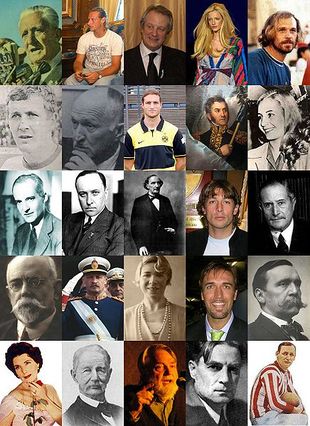
2nd row: Carlos Babington • Deolindo Bittel • Diego Klimowicz
José de San Martín • Eva Perón
3rd row: Luis Federico Leloir • Richard Walther Darré • Bartolomé Mitre • Gabriel Heinze • Carlos Ibarguren
4th row: Francisco Moreno • Juan Carlos Onganía • Alfonsina Storni • Gabriel Batistuta • Carlos Pellegrini
5th row: Libertad Lamarque • Hermann Burmeister • Osvaldo Bayer • Roberto Arlt • Jorge Brown
White Argentines are the Argentine people of predominantly European/Middle Eastern descent. They are descendants of colonists from Spain and Portugal during the colonial period prior to 1810, and mainly of immigrants from Europe and the Middle East in the great immigratory wave during the late 19th century and early 20th century.[1][2][3] Although no official census data exist, some international sources claim that they make up 85.8%,[4] 89.7%[5] or 97%[6] of Argentina's population.
Usage of the term
White Argentine -or White Argentinian- is an umbrella term including various distinct ethnicities (colectividades in Spanish) -including Italian Argentines, Spanish-Argentines, French Argentines, Irish Argentines, German Argentines, Arab Argentines, and many others- as well as the mixture among them. This term is most frequently used in English language sources[7] [8]. Its direct equivalent in Spanish language, "argentino blanco", appears in some Argentine bibliography,[9] but it is not currently used in Argentina neither as a legal/official term, nor in common speech.
Another equivalent in Spanish might be "Criollo", but that term was originally restricted to the unmixed descendants of Spaniards, born in the Americas. Given the great diversity of ethnic origins of the European immigrants of the 19th and 20th centuries in Argentina, "Criollo" might not be the most accurate term. Nevertheless, the term is sometimes used by some Spanish-speaking authors as synonym for White Latin American, regardless of the European ethnicity of origin.[10] Besides, in Argentina the meaning of Criollo was intentionally changed during the years ot the great immigratory wave -making it ambiguous- so it might include all the Argentina-born individuals, regardless of race, as opposed to all the European/Middle Eastern newcomers and their children, who were collectively nicknamed Gringos.[11]
Some definitions of this term include Jewish (both Ashkenazi and Sephardic) and Arab people, coming from Europe and the Middle East. Although these groups are sometimes considered non-White, in Argentina they are frequently classified as "whites" for their resemblance of other European Mediterranean peoples, and in opposition to all the Amerindian, Mestizo, Black/Mulatto and East Asian ethnic groups. The same happens in the rest of the Americas; for example, the US Census Bureau defines White people as "having origins in any of the original peoples of Europe, the Middle East, or North Africa."
Distribution
White Argentines may live in any part of the country, but their concentration varies according to the region. Due to the fact that the main entrance gate of European immigrants was the port of Buenos Aires, they settled especially in the central-eastern region called Pampas (the provinces of Buenos Aires, Santa Fe, Córdoba, Entre Ríos and La Pampa),[11] and in the southern region called Patagonia (the provinces of Río Negro, Neuquén, Chubut, Santa Cruz and Tierra del Fuego), for it was populated mainly by people coming from the Pampas. They also reside in important numbers in the central-western region called Cuyo (the provinces of Mendoza, San Juan and San Luis) and the north-eastern region called Litoral (the provinces of Corrientes, Misiones, Chaco and Formosa).
They are also found in the major cities of the north-western provinces of Salta, Jujuy, Tucumán, Catamarca, La Rioja and Santiago del Estero, but they are nearly non-existent in the rural areas. Their presence in this region is lesser due to several reasons: it was the most densely populated region of the country (mainly by Amerindian and Mestizo people) until the immigratory wave of 1857-1940, and it was the area where the European newcomers settled the least.[11] During the last decades, due to internal migration from these northern provinces, and due to immigration especially from Bolivia, Perú and Paraguay (which have Amerindian and Mestizo majorities[12][13][14]), the percentage of White Argentines in certain areas of the Greater Buenos Aires, and the provinces of Salta and Jujuy has significantly decreased as well.[15]
Estimates
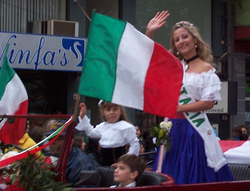
As it was explained in the introduction of this article, no official census data exist on the precise amount or percentage of White Argentines today; this is because Argentina's National Institute of Statistics and Censuses (INDEC) does not conduct ethnic/racial censuses, nor includes questions about ethnicity. The National Census conducted on 27 October 2010 only included questions on Indigenous peoples -completing the survey performed in 2005- and on Afro-descendants.[17]
Nevertheless, most international sources agree in their claim that White Argentines make up at least 85% of Argentina's population. Worldstatesmen.org -an on-line encyclopedia- estimates an 89.7% (86.4% White/European plus 3.3% Arab),[5] and the World Fact File powered by Dorling Kindersley Books also claims an 85% (83% Indo-European, plus 2% Jewish).[18] Other on-line encyclopedias also display similar percentages.[19]
The Joshua Project -that provides information on ethnic people groups around the world, with missionary purposes- states that White Argentines and other whites (Europeans and Middle-Easterners) in Argentina comprise 85.8% [4] of the total population. This percentage does not show explicitly, but after doing some mathematics, the results are as follows: Argentinians White -the resulting ethnic group out of the melting pot of immigration in Argentina- sum up 29,031,000 or 72.3% of the population. The other European/Caucasus ethnic groups and Uruguayans White sum up 4,258,500 (10.6%), and Arabs sum 1,173,100 more (2.9%). All together, Whites in Argentina would comprise 34,462,600 or 85,8% out of a total population of 40,133,230.
The work Ethnic Groups Worldwide: A Ready Reference Handbook, written by David Levinson, also provides an estimate of 85% of people of European origins in Argentina.[20]
Another work titled Composición Étnica de las Tres Áreas Culturales del Continente Americano al Comienzo del Siglo XXI, which is a very complete and detailed study on the ethnic composition of Ibero-America written by Mexican UAEM scholar Francisco Lizcano Fernández, also estimates a White population of 87.8% in Argentina, or about 32,551,000 people. This figure comprises 85% Criollos (the term he uses for Whites) plus 2.8% Arabs, that he classifies as "Asians".[10]
The figure of 97%[6] given by the CIA Factbook seems to be exaggerated; either it counts both White and Mestizo population all together,[20] or it is the result of the successful campaign implemented by Argentina's ruling elite in the early 20th century to present the country as much White as possible.[11] It is frequently consulted and used as source for many news articles.[21]
History
Colonial and post-independence period
The presence of White people in what is now Argentina began in 1516, when Spanish Adelantado Juan Díaz de Solís explored the Río de la Plata and named it "Mar Dulce" (Sweet Sea). In 1527, explorer Sebastián Gaboto founded the fort of Sancti Spiritus, near Coronda, Santa Fe; this was the first Spanish settlement on Argentine soil. The process of Spanish occupation continued with expeditions coming from Upper Peru (now Bolivia), that founded Santiago del Estero in 1553, and the cities of San Miguel de Tucumán (1565) and Córdoba (1573) later on. Taking Asunción as an operative base, other Spanish expeditions founded the cities of Buenos Aires (1580) and Corrientes (1588).
Although the estimates vary, it is a fact that Spanish immigration from the peninsula towards the New World was scanty during all the colonial period. Some estimates state that less than 200,000 Spaniards arrived in the Americas during the period 1509-1790.[22] On the other hand, Peter Muschamp Boyd-Bowman -an Emeritus Professor of Spanish Linguistics- estimated that about 437,669 Spaniards went and established in the American possessions between 1506 and 1650; of this total, a figure between 10,500 and 13,125 Peninsulares settled in the Río de la Plata region during the 18th century.[23]
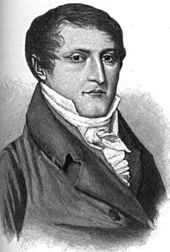
It was not until the creation of the Viceroyalty of Río de la Plata in 1776, that the first censuses with classification into castas were conducted. The 1778 Census ordered by viceroy Juan José de Vértiz in Buenos Aires revealed that, of a total population of 37,130 inhabitants (including both city and surrounding countryside), the Spaniards and Criollos numbered 25,451, or 68.55% of the total. Another census carried out in the Corregimiento de Cuyo in 1777 showed that the Spaniards and Criollos numbered 4,491 (or 51.24%) out of a population of 8,765 inhabitants. In Córdoba (city and countryside) the Spanish/Criollo people comprised a 39.36% (about 14,170) of 36,000 inhabitants.[24]
Nevertheless, these censuses were generally restricted to the cities and the surrounding rural areas, so little is known about the racial composition of large areas of the Viceroyalty -as the Litoral, for example- though it is supposed that Spaniards and Criollos were always a minority, with the other castas comprising the majority. It is worth noting that, since a person who was classified as Peninsular or Criollo had access to more privileges in the colonial society, many Castizos (or "White Mestizos") purchased their limpieza de sangre (purity of blood). This passing was common during the colonial period, so some of the figures shown above may include Castizos that "passed" as White.[24]
Although being a minority in demographics terms, the Criollo people played a leading role in the independentist movement that started in 1810 and led to the independence of Argentina from Spain in 1816. Argentine national heroes such as Manuel Belgrano and José de San Martín, military men as Cornelio Saavedra, José Rondeau, Carlos María de Alvear and Miguel de Azcuénaga, and politicians as Juan José Paso, Mariano Moreno, Juan José Castelli, and Gervasio Posadas were mostly Criollos of Spanish, Italian or French descent; some Spaniards also collaborated with the movement, as Domingo Matheu and Juan Larrea. Nevertheless, the war effort fell on the Mestizo, Mulatto and Black populations, who composed most of the troops during the wars of independence, and so they suffered heavy losses of lives, as they were frequently used as "cannon fodder".
In 1822, Bernardino Rivadavia -then Minister of Government of Buenos Aires Province- ordered Ventura Arzac to conduct a new Census in the city, and it showed these results: the city had then 55,416 inhabitants, of which 40,000 were White (about 72.2%). Of this total of Whites, a 90% were Criollos, a 5% were Spaniards, and the other 5% were from other European nations.[26]
After the wars for independence, a long period of fierce internal struggle followed. During the period 1826-1852, the fight was mainly between Federalist (those who supported the provinces' autonomy) and Unitarian caudillos (who supported a centralized government). After the fall of Juan Manuel de Rosas in 1852, and until 1861, the conflict was between Buenos Aires Province Autonomists and the Argentine Confederation Federal government. Once again, the leading men involved in the fight were almost entirely Criollos of Spanish descent, and the troops were mostly Mestizo and Mulatto people. Among those Criollos leaders were: Juan Manuel de Rosas, Ángel Pacheco, Facundo Quiroga, Juan Lavalle, Gregorio Aráoz de Lamadrid, Pedro Ferré, Justo José de Urquiza, Bartolomé Mitre, Santiago Derqui, etc. During that period some Europeans settled in the country as well -sometimes hired by the local governments. Notable among them, Saboyan litographist Charles H. Pellegrini (President Carlos Pellegrini's father) and his wife Maria Bevans, Napolitan journalist Pedro de Angelis, and German physician/zoologist Hermann Burmeister.
An estimate by José Ingenieros states that in 1826 the Argentine territory was populated by 630,000 people, of whom only 13,000 were White; if this figure were correct, Whites comprised a mere 1.66% of the total.[27] According to historian John W. White's estimate, those percentages had barely changed by 1852; out of a total 785,000 inhabitants, a 22,000 were White -a 2,8%- divided in 15,000 Criollos and 7,000 Europeans.[28]
Because of the long civil conflict, there were neither economical resources nor political stability to carry out any census until the 1850s, when some provincial censuses were organized. Anyway, these censuses did not continued with the classification into castas typical of the pre-independence period. The first post-independence census conducted in Buenos Aires took place in 1855; it showed that there were 26,149 European inhabitants in the city. Among the nationals there is no distinction of race, but it does distinguish literates from illiterates; by that time formal education was a privilege almost exclusive for the upper sectors of society, who were predominantly White. If both groups of European residents and the 21,253 Argentine literates are summed, it might be estimated that about 47,402 White people resided in Buenos Aires in 1855; they would comprised about 51,58% of a total population of 91,895 inhabitants.[29]
The great immigratory wave from Europe (1857-1940)
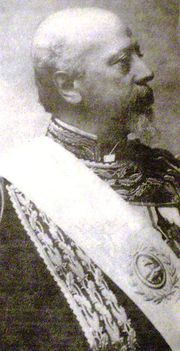
In February 1856, the municipal government of Baradero granted lands for the settlement of ten Swiss families in an agricultural colony near that town. Later that year, another colony was founded by Swiss immigrants in Esperanza, Santa Fe. In spite of these isolated provincial initiatives, it was not until the Argentine Confederation and the Buenos Aires Province definitively unified in 1862 -and a strong central government could be established- that Presidents Bartolomé Mitre, Domingo Sarmiento and Nicolás Avellaneda implemented policies that encouraged massive European immigration. In 1876, during Avellaneda's presidential period, the Congress voted and sanctioned the new Law 817 of Immigration and Colonization. During the following decades, and until the mid-twentieth century, waves of European settlers came to Argentina. Major contributors included Italy (initially from Piedmont, Veneto and Lombardy, later from Campania, Calabria, and Sicily),[30] and Spain (most were Galicians and Basques, but there were Asturians, Cantabrians, Catalans, and Andalusians).
Smaller but significant numbers of immigrants include Germans, primarily Volga Germans from Russia, but also Germans from Germany, Switzerland, and Austria; French which mainly came from the Occitania region of France; Slavic groups which most were Croats and Poles, but there also were Ukrainians, Belarusians, Russians, Bulgarians, Serbs and Montenegrins; British came mainly from England and Wales: Irish who were escaping from the Potato famine or British rule; Scandinavians from Sweden, Denmark, Finland, and Norway. Smaller waves of settlers from Australia and South Africa, and the United States can be traced in Argentine immigration records.
From the former Ottoman Empire came mainly Greeks, Armenians and Arabs (from what is now Lebanon and Syria). They entered the country with Turkish passport, so they were colloquially nicknamed "turcos". The majority of Argentina's Jewish community derives from immigrants of north and eastern European origin (Ashkenazi Jews), and about 15–20% from Sephardic groups from Syria. Argentina is home to the fifth largest Ashkenazi Jewish community in the world. (See also History of the Jews in Argentina).
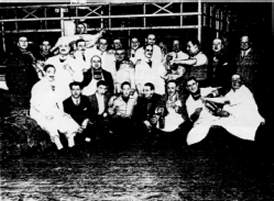
This migratory influx had mainly two effects on Argentina's demography:
1) The exponential growth of the country's population. In the first National Census of 1869 the Argentine population was just 1,877,490 inhabitants, in 1895 it had doubled up to 4,044,911, in 1914 it had reached 7,903,662, and by 1947 it had doubled again up to 15,893,811. It is estimated that by 1920, more than 50% of the residents in Buenos Aires had been born abroad. According to Zulma Recchini de Lattes' estimate, if this great immigratory wave from Europe and the Middle East had not happened, Argentina's population by 1960 would have been less than 8 millions, while the national census carried out that year revealed an amount of 20,013,793 inhabitants.[31] As it is shown in the chart below, Argentina received a total amount of 6,611,000 European and Middle-Eastern immigrants during the period 1857-1940.[32]
2) A radical change in its ethnic composition; the 1914 National Census revealed that around 80% of the national population were either European immigrants, their children or grandchildren.[33] Among the remaining 20% (those descended from the population residing locally before this immigrant wave took shape), around a third were White. Put down to numbers, this means that about an 86.6% (out of a total population of 7,903,662) or 6,844,000 people residing in Argentina were White.[34]
The distribution of these European/Middle Eastern immigrants was not uniform across the country; most newcomers settled in the coastal cities and the farmlands of Buenos Aires, Santa Fe, Córdoba and Entre Ríos. For example, the 1914 National Census showed that, of almost three million people -2,965,805 to be exact- living in the provinces of Buenos Aires and Santa Fe, 1,019,872 were European immigrants, and one and a half million more were children of European mothers. So Whites comprised at least an 84,9% of the Pampa Gringa, as it was called. But this was not the same situation in the rural areas of the northwestern provinces; there the immigrants (mostly of Syrian-Lebanese origin) represented a mere 2.6% (about 15,600) of a total rural population of 600,000 in Jujuy, Salta, Tucumán, Santiago del Estero and Catamarca.[11][35]
European immigration continued to account for over half the nation's population growth during the 1920s, and was again significant (albeit in a smaller wave) following World War II.[33]

Origin of the immigrants until 1940
Source: Dirección Nacional de Migraciones, National Bureau of Migrations, 1970.
2nd immigratory wave after World War II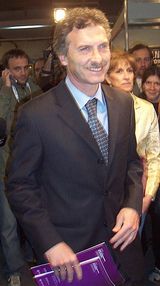 Mauricio Macri -the Mayor of Buenos Aires City- is the son of businessman Francisco Macri, who was born in Rome and emigrated as a young man in 1949. After the Second World War, many Europeans fled to Argentina, escaping the hunger and poverty of the post-war period. According to the National Bureau of Migrations, during the period 1941-1950 at least 392,603 Europeans entered the country: 252,045 Italians, 110,899 Spaniards, 16,784 Poles, 7,373 Russians and 5,538 French.[37] Among the notable Italian immigrants in that period were protest singer Piero De Benedictis (emigrated with his parents in 1948),[38] actors Rodolfo Ranni (emigrated in 1947)[39] and Gianni Lunadei (1950),[40] César Civita (1941),[41] businessman Francisco Macri (1949),[42] Pablo Verani (1947),[43] and rock musician Kay Galiffi (1950).[44] Argentina also received thousands of Germans who came bankrupt -like Oskar Schindler and his wife, for example- and Ashkenazi Jews. Unfortunately, among those "good" Germans there were hundreds of Nazi war criminals; Adolf Eichmann, Josef Mengele, Erich Priebke, Rodolfo Freude (who became the first director of Argentine State Intelligence), and the Ustaše Head of State of Croatia, Ante Pavelić -among others- entered the country in this period. It is still matter of debate whether the Argentine government of the time was aware of the presence of these criminals on Argentine soil or not; but the consequence was that Argentina was considered a Nazi Haven for several decades.[45] White Argentines, therefore, likely peaked as a percentage of the national population at over 90% on or shortly after the 1947 census. The flow of European immigration continued during the 1950s, but -compared to the previous decade- it is evident that it was diminishing considerably. The Marshall Plan implemented by the United States to help Western Europe recover from the consequences of World War II was working, and emigration was not such a necessity. During the period 1951-1960, only 242,889 Europeans entered Argentina: 142,829 were Italians, 98,801 were Spaniards, 934 were French, and 325 were Poles. The next decade (1961–1970), the total amount of European immigrants barely reached 13,363 (9,514 Spaniards, 1,845 Poles, 1,266 French and 738 Russians).[37] During the 1970s, the European immigration was nearly non-existent; the internal struggle inside the Peronism (Montoneros versus Triple A) caused terrorism and guerrilla warfare first, and a brutal repression by the Armed Forces followed after 1976 under the name of Proceso de Reorganización Nacional. Such an internal situation encouraged emigration rather than immigration -at least by the Europeans- and this is also evident in the numbers; during the period 1971-1976 at least 9,971 Europeans left the country.[37] During the period 1976-1983 thousands of White Argentines and numerous Europeans were kidnapped and killed in clandestine centers by the grupos de tareas (task groups) of the military dictatorship. Among the White Argentines who were victims of the repression can be mentioned: Haroldo Conti, Dagmar Hagelin, Rodolfo Walsh, Héctor Oesterheld (all presumably assassinated in 1977) and Jacobo Timerman (who was liberated in 1979; he went to exile in Israel, and returned in 1984). In 1983-1984, the CONADEP -a special comission gathered by President Raúl Alfonsín and led by writer Ernesto Sábato- investigated and documented 8,960 cases[48] clarifying that the list was by no means exhaustive; so some other estimates vary between 13,000 and 30,000 missing people. White Latin American immigrantsAs it was mentioned in the Distribution section, since the 1960s until now, the main source of immigration switched from Europe to the bordering South American countries. During the period in between the Censuses of 1895 and 1914, the immigrants from Europe comprised 88.4% of the total, and the Latin American immigrants represented only the 7.5%. By the decade of 1960-1970, this tendency had completely reverted: the Latin American immigrants were the 76.1% and the Europeans merely comprised an 18.7% of the total.[49] Given that the main sources of South American immigrants since the 1960s have been Bolivia, Paraguay and Perú, most of these immigrants have been either Amerindian or Mestizo, for these groups represent the ethnic majorities in their countries of origin.[12][13][14] The increasing numbers of immigrants from these sources has caused the percentage of White Argentines to be reduced significantly in certain areas of the Greater Buenos Aires; mainly in the partidos of Morón, La Matanza, Escobar and 3 de Febrero, and the porteño neighbourhoods of Flores, Villa Soldati, Villa Lugano and Pompeya.[15] Unfortunately, many Amerindian or Mestizo people of Bolivian/Paraguayan/Peruvian origin have suffered either of racist discrimination and violence[50][51] or have been victims of sexual slavery[52] and forced labor in textile sweat shops.[53] 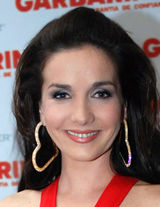 Natalia Oreiro is a White Uruguayan actress/singer of Galician, Italian and French descent. She resides in Argentina since 1993, and married Divididos' guitarist Ricardo Mollo. Nevertheless, generalizations must not be made; some White immigrants from Bolivia, Perú and Paraguay have entered Argentina. Among the Paraguayan immigrants, for example, there have been many of German and Slavic descent, with surnames like Hoffmann, Schneider or Surnyak. Another example is well-known actor Arnaldo André, who migrated in the 1970s and has developed a long successful career in Argentina. Uruguayan immigrants represent a very distinct case, for they may pass unnoticed as "foreigners". Uruguay received a great part of the same immigratory influx that changed Argentina´s ethnic profile, so most Uruguayans are White; estimates of White population in Uruguay oscilate from 87.4%[54] to 94.6%.[55] Besides, Uruguayans and Argentinians speak the same language variety; the Rioplatense Spanish, which is heavily influence by the entonation patterns of the Italian language's southern dialects.[56] Unlike the cases of racist discrimination against Bolivians, Paraguayans and Peruvians, Uruguayans have not suffered any type of racism or xenophobia against them. According to the Uruguayan collectivity, 218,000 Uruguayans migrated to Argentina between 1960 and 1980.[57] The official censuses show a slow growth of Uruguayan immigrants: 51,100 in 1970; 114,108 in 1980 and 135,406 in 1991; but the 2001 National Census shows a lower figure: 117,564.[58] Other source estimates the number of White Uruguayans and their descendants in 725,000.[4] Among the Uruguayan immigrants who have settled, developed their professional career, and have had their children in Argentina, we may find: sports journalist Víctor Hugo Morales, actor/comedian Berugo Carámbula, his daughter María and his son Gabriel Carámbula, actress/singer Natalia Oreiro, actresses China Zorrilla and Adela Gleijer, actors Osvaldo Laport and Juan Manuel Tenuta, among many others. Argentina has also received White people from other Latin American countries, such as Chile and Cuba. Estimates of the White population in Chile greatly vary from 22%[59] or 30%,[60] up to 52.7%[10] or 64%;[61][62] so about half of all Chilean immigrants (212,429 in 2001[58]) and their descendants in Argentina might be White. Among these immigrants, they can be mentioned: Chilean model/DJ Cecilia Amenábar (who was married with Gustavo Cerati and had two children with him), María Ostoić -Néstor Kirchner's mother (born in Punta Arenas in a family of Croatian descent)- and Cuban neurosurgeon Roberto Quiñones (Cuban dissident Hilda Molina's son; he married an Argentine woman and they had two sons[63]). 3rd immigratory wave from Eastern Europe (1994-2000) President Carlos Saúl Menem (1989-1999); his parents were of Syrian descent. He offered the European Union to receive immigration from Eastern Europe in 1992. In 1992, after the fall of the Communist regimes of the Soviet Union and its allies, the governments of Western Europe were worried about a possible massive exodus from Eastern Europe and Russia. President Carlos Saúl Menem -in the political framework of relaciones carnales with the Western World- offered to receive part of that emigratory wave in Argentina. On 19 December 1994, Resolution 4632/94 was enacted, allowing a "special treatment" for all the applicants who wished to emigrate from the republics of the ex-Soviet Union. Summarizing, from January 1994 till December 2000, a total 9,399 Eastern Europeans travelled and settled in Argentina. Of the total, 6,720 were Ukrainians (71.5%), 1,598 were Russians (17%), 160 Romanians (1.7%), 122 Bulgarians (1.3%), 94 Armenians (1%), 150 Georgians/Moldovans/Poles (1,6%) and 555 (5.9%) travelled with Soviet passport.[64] An 85% of the newcomers were under age 45, and 51% had terciary level education, so most of them integrated quite rapidly into Argentine society, although some had to work for lower wages than expected at the beginning.[65] Among them, there were 200 Romanian Gypsy families that arrived in 1998, and 140 more Romanian Gypsies who migrated to Uruguay in 1999, but only to enter Argentina later by crossing the Uruguay river through Fray Bentos, Salto or Colonia.[66] After this wave from Eastern Europe, White/European immigration in Argentina has not stopped either. According to the National Bureau of Migrations, some 14,964 Europeans have settled in Argentina (3,599 Spaniards, 1,407 Italians and 9,958 from other countries)during the period 1999-2004. To this figure, some 8,285 Americans and 4,453 Uruguayans may be partially added, since these countries have White majorities of 75%[67] and 87%[54] in their populations.[68] The Myth of White ArgentinaThis myth was created by Argentina's ruling elite (La Generación de 1880, led by Julio Argentino Roca) during the late 19th century and the early 20th century; it stated that almost all the inhabitants of Argentina were of European origin, i.e. "White". This same period was the time of formation of all the national states in Hispanic America, and the elites of countries like Mexico and Perú chose to create myths of "Mestizo countries" -where there was a harmony between the Spanish and Amerindian cultural and ethnic elements within those societies- implementing policies of "creolization" or assimilation of their Amerindian populations into the Criollo society. Thus, popular education systems were established in the official Spanish language, leaving aside the Amerindian tongues. Education was also an instrument to spread criollo culture, trying to erradicate some "undesirable" indigenous habits, customs, festivities, etc.[11] A similar process took place in Argentina, but this time the country's ruling elite chose to create the myth of a "White country" instead. By that moment the great immigratory wave from Europe was really changing the ethnic profile of Argentina -at least in the Pampas, the most populated region- so it was not difficult to present the country as "White" so as to promote European investments, mainly by British companies. Besides, to manipulate the percentages of White people, racial categories were wiped out from the censuses questionnaires, leaving only national categories, thus leading to the undercounting of Mestizos and Afro-Argentines. Furthermore, the meaning of the word Criollo was intentionally changed during those years -making it ambiguous- so it might include all the Argentina-born individuals, regardless of race, so they could also be counted as White, and inflate the percentages. In the short and long runs, the propaganda campaign organized by the Generación de 1880 was very successful, for even nowadays two important reference books in English language, the CIA Factbook and the Columbia Encyclopedia, display figures of 97%-98% White people living in Argentina.[6][11] The myth also percoladed into Argentina's self-image in its own educational system. Well into the 1980s, many textbooks used in the secondary schools showed figures of 99% White people in Argentina, and only 1% Amerindians.[69] All these comments on this myth do not intend to imply that it is a complete lie at all; on the contrary. The myth of a White Argentina is nowadays partially false in degree, but it has proved to be true in essence. The percentage of 97% Whites in Argentina was probably never true; but it is a fact that White people nowadays comprise a majority of the country's population. As it was shown in the Estimates section, all international sources agree in figures around 85%.[5][18][4][10] [20]
Influence on Argentine cultureAs for all Latin America, many cultural products in Argentina are the result of a fusion of European, Amerindian and Black African elements. Nevertheless, the impact of European immigration on both Argentina's culture and demography has been so deep and extensive, that their culture has become mainstream and it is shared by the rest of Argentines, so it is not perceived as a separate "White" culture. Even those traditional elements that have Amerindian origin -as the mate and the Andean music- or Criollo origin -the asado, the empanadas, and some genres within folklore music- were rapidly adopted, assimilated and sometimes modified by the European immigrants and their descendants, and so they were given a "European flavor".[33][7][70] This is a review of the main Criollo/European contributions to Argentine culture; and also a review of the most prominent Argentinians of European/Middle Eastern descent in every field of culture in Argentina. The lists of notable White Argentines may include some people who are European by birth, but they are considered Argentines because they immigrated during their childhood/youth, and developed their careers and died in Argentina. MusicTango Carlos Gardel (1890-1935) is the most famous singer-songwriter of classical tango; he was -reportedly- French by birth.[71] Argentine tango is a hybrid genre, result of the fusion of different ethnic and cultural elements, so well intermingled that it is difficult to identify them separately. According to some experts, tango has combined elements from three main sources: 1) The music played by the Black African communities of the Río de la Plata region. Its very name might derive from a word in Yoruba -a Bantu language- and its rhythm appears to be based on candombe.[72] 2) The milonga campera, a popular genre among the gauchos that lived in the Buenos Aires countryside, and later moved to the city looking for better jobs. 3) The music brought by the European immigrants: the Andalucian tanguillo, the polka, the waltz and the tarantella.[73] They heavily influenced its melody and its sound by adding instruments such as piano, violin and -especially- bandoneón.  Ástor Piazzolla (1921-1992) was one of the finest bandoneonists ever; his parents were Italian immigrants from Trani, Apulia.[74] In spite of this tripartite origin, tango mainly developed as a urban music, and it was assimilated and embraced by the European immigrants and their descendants; most icons of the genre were either European or had European ancestry. Among the tango pioneers of the early 20th century we find Juan de Dios Filiberto (his grandparents were from Genova), Juan Maglio, Eduardo Arolas (his parents were French), Enrique Delfino and Roberto Firpo. Carlos Gardel, the greatest exponent of classical tango in the 1930s, was -reportedly- born in France, and his songwriting partner Alfredo Le Pera had Calabrian ancestry. Any list of important singers, composers, and arrangers of the Golden Age of tango -in the 1940s and 1950s- shows a collection of Italian and French surnames: Enrique Santos Discepolo (his father was an Italian musician), Homero Manzi, Pascual Contursi, Sebastián Piana, Enrique Cadícamo, Raúl Garello, Julio De Caro (both his parents were Italian), Osvaldo Fresedo, Ignacio Corsini (born in Sicily), Enrique Francini, Agustín Magaldi and Armando Pontier. The most prestigious orchestra directors were of Italian descent: Aníbal Troilo, Carlos Di Sarli (his father was Italian), Juan D'Arienzo and Osvaldo Pugliese. Singer Alberto Castillo -known for his song Al compás del tamboril- was actually surnamed De Lucca. Juan Carlos Cobián, another prestigious composer and orchestra director, had his father born in Spain. 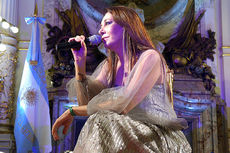 Adriana Varela is a famous tango singer of Italian descent -her real surname is Lichinchi- born in Avellaneda. The creator of New Tango in the 1960s, bandoneonist and composer Astor Piazzolla, had direct Italian ancestry, and his songwriting partner Horacio Ferrer was of French descent. Other artists of European descent during the 1960s and 1970s were Roberto Goyeneche (with Basque ancestry[75]) and Edmundo Rivero (with Spanish and British descent). Current exponents, such as singer-songwriter Cacho Castaña and singers Susana Rinaldi (nicknamed la Tana) and Adriana Varela also are of Italian descent.
FolkloreWhen the Spaniards arrived in what is now Argentina, the Amerindian inhabitants already had their own musical culture: instruments, dances, rhythms and styles. Much of that culture was lost during and after the conquest; only the music played by the Andean peoples survived in the shape of chants such as vidalas and huaynos, and in dances like the carnavalito. The peoples of Gran Chaco and Patagonia -areas that the Spaniards did not effectively occupied- kept their cultures almost untouched until the late 19th century. 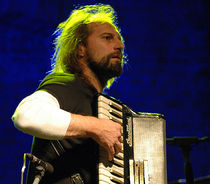 Chango Spasiuk is a prestigious composer and accordion player; his grandparents were Ukrainian immigrants who settled in Misiones.[76] The major Spanish contribution to music in the Río de la Plata area during the colonial period was the introduction of three instruments: the vihuela or guitarra criolla, the bombo legüero and the charango (a small guitar, similar to the tiple used in the Canary Islands; made with the shell of an armadillo). Once the Criollos obtained their independence from Spain, they had the chance to create new musical styles; dances like pericón, triunfo, gato and escondido, and chants like cielito and vidalita all appeared during the post-independence period, especially in the 1820s.[77]
The ethnic change that Argentina was undergoing is also evident in the lyrics of some songs; for example, the creole waltz La pulpera de Santa Lucía refers to a blond-haired, blue-eyed waitress in a pulpería of Buenos Aires countryside.
Another example is the chamamé titled La Oma, that describes a blue-eyed old woman of German origin that lived in the Chaco region; Oma is the German word for "grandmother" or "old woman".
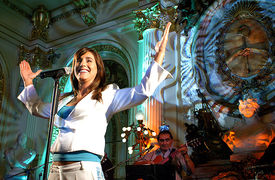 Soledad Pastorutti is a young folklore singer born in Arequito, Santa Fe of Italian descent; she was part of a new "folklore boom" in the 1990s. One of her major hits is A Don Ata, a chacarera written by Mario Álvarez Quiroga paying homage to Atahualpa Yupanqui. Other native rhythms -like chacarera and zamba- were not so heavily influenced by the immigrants, but they began to be played with other European instruments; one example is Sixto Palavecino's use of the violin to play the chacarera. Regardless of the origin of the different rhythms and styles, European immigrants and their descendants rapidly assimilated the local music as their own, and contributed to those genres creating new songs. A list -not exhaustive- of notable White Argentines that have written and/or recorded folklore music includes: Songwriters: Ariel Petrocelli, Artidorio Cresseri, Luis Profili (author of Zamba de mi esperanza), Armando Tejada Gómez, Carlos Guastavino, and songwriting teams such as Ariel Ramírez - Félix Luna and Gustavo Leguizamón - Manuel Castilla. Singer-songwriters: Carlos DiFulvio, Teresa Parodi, Chango Spasiuk (his grandparents emigrated from Ukraine), Chango Nieto, Hernán Figueroa Reyes, César Isella, Facundo Saravia, Eduardo Falú (of Syrian descent), Jorge Rojas, Los Hermanos Ábalos (with Criollo and Italian ancestry). Performers: Soledad Pastorutti, Oscar "Chaqueño" Palavecino (both with Italian ancestry) , Jorge Cafrune (of Arab descent), Antonio Tormo (his parents were from Valencia, Spain), Lucía Ceresani. Besides, many TV hosts of programs specialized on folklore were of Lebanese or Italian ancestry; Julio Mahárbiz, Quique DaPiaggi and Carlos Giachetti. Andean music was much less influenced by Criollo and European culture, so it has remained quite "pure" -except for the use of charango and Spanish language- and it is most frequently written, performed and recorded by Mestizo and Amerindian Argentines.
Rock
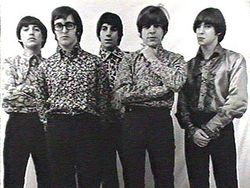 Los Gatos in 1967. From left to right: Ciro Fogliatta, Kay Galiffi, Oscar Moro, Lito Nebbia and Alfredo Toth. Its members had Italian, Spanish and Ashkenazi ancestry. As for tango, Argentine rock -locally named rock nacional- appeared and developed in two major cities: Buenos Aires and Rosario. Both cities had White majorities in the 1960s -and still have- so most of the pioneers and current exponents of this genre are either Europeans or their descendants. Through the decades, Argentine rock musicians have received much influence of American and British rock sub-genres, and combined them with local elements, creating then a very original and distinct musical style. The first rock and roll songs -sung in Spanish- that were heard in Argentina were La Bamba (sung by Chicano artist Ritchie Valens) and translated cover versions performed by Mexican bands such as Los Teen Tops and Los Blue Caps of songs originally sung by Bill Haley, Elvis Presley, Chuck Berry, Buddy Holly and Jerry Lee Lewis. Some of these songs became classics in Spanish; for example La Plaga (Good Golly, Miss Molly, by Little Richard) and Popotitos (Bony Moronie, by Larry Williams). The first Argentine rock band was formed in 1956; they were Mr. Roll & the Rockers, led by Eddie Pequenino (featuring Lalo Schifrin as piano player). In the early 1960s many rock classics of the 1950s were performed locally by Los Red Caps -a fictional band led by Ramón "Palito" Ortega for the TV program El Club del Clan- and Sandro & Los de Fuego. Notwithstanding, by the late 1960s the local musicians were ready to stop copying American rock, and create original songs in Spanish to express their own feelings. 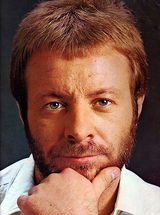 León Gieco is a well-known singer-songwriter of Italian descent, born in Cañada Rosquín, Santa Fe. His major hit is Sólo le pido a Dios. The single La balsa / Ayer nomás -recorded in 1967 by Los Gatos, a band from Rosario, Santa Fe- is considered the first single disc of genuine rock "made in Argentina".[79] Los Gatos, Almendra (formed by Luis Alberto Spinetta, Edelmiro Molinari, Rodolfo García and Emilio Del Guercio), Manal (Javier Martínez, Claudio Gabis -of Ashkenazi descent- and Alejandro Medina) and Vox Dei (Ricardo Soulé -of French descent-, Willy Quiroga, Juan Carlos Godoy and Rubén Basoalto) are considered the pioneer bands of Argentine rock. Los Gatos played mostly beat music, Almendra had a mixed style of rock/pop/instrumental music, Manal's sound had a strong influence of blues-rock and Vox Dei was the first exponent of Argentina's hard-rock. In the early 1970s, the duet Sui Generis -Charly García and Nito Mestre- entered the musical scene with an acoustic/folk sound, and gained a massive audience among teenagers. After their break-up in 1975, their folk style was continued by two other duets: Pastoral -Alejandro DeMichele and Miguel Erausquin- and Vivencia.[80] Band Arco Iris (led by Oscar winner Gustavo Santaolalla) also reached popularity with their hit single Mañanas campestres in 1972. Almendra bisdanded in 1971, so Spinetta created Pescado Rabioso, with a strong rock/blues sound; among its members there was a young David Lebón (of Ashkenazi descent). In the mid-seventies, Argentine rock was heavily influence by British symphonic rock, so new bands such as Luis Spinetta's Invisible, Edelmiro Molinari's Color Humano, Charly García's La Máquina de Hacer Pájaros, Crucis and ALAS appeared. But their music was not a mere copy of the foreign rock; for example, in Invisible's album El Jardín de los Presentes (1976) and its track Las golondrinas de Plaza de Mayo, Spinetta and his partners combined the symphonic rock with tango, creating the tango-rock. A similar case is Alas' album Pinta tu Aldea (1977) and the song La caza del mosquito, written by Gustavo Moretto. Charly García also made fusions with folklore music; for example, Sui Generis' song Cuando comenzamos a nacer, has an intro with reminiscence of Andean music. Other Argentines of European descent that stood out in the 1970s were León Gieco (who wrote his pacifist hymn Solo le Pido a Dios in 1978) with his folk-rock style, and Norberto "Pappo" Napolitano with his blues-rock band Pappo's Blues. 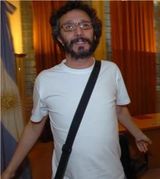 Fito Páez is a very prolific singer-songwriter of Spanish descent, born in Rosario, Santa Fe. His major hits include Giros, Y dale alegría a mi corazón, and El amor después del amor. In 1982, when the Argentine Armed Forces recovered the Falkland/Malvinas Islands, and the war with Great Britain began, the military dictatorship forbid the broadcasting of music in English; so the radios had to airplay more Argentine rock than ever before.[81] This caused that many new solo artist had much more space to be heard: Alejandro Lerner, Sandra Mihanovich, Celeste Carballo, Raúl Porchetto, etc. Serú Girán -the band formed by Charly García in 1978 (with David Lebón, Pedro Aznar and Oscar Moro)- also reached the top of its popularity in 1982 with the live album No Llores por Mí, Argentina. Meanwhile, Pappo formed the band Riff with brothers Michel and Danny Peyronel (with French ancestry), Victor "Vitico" Bereciartúa and Bob Serafine, to play heavy metal. After the restoration of democracy in 1983, the rock scene flourished with many new artists who had freedom to express themselves -even praising hedonism in their lyrics- such as Virus from La Plata and Soda Stereo. Among these new artists, a group of musicians from Rosario -that is why they were collectively called "Rosariazo"- deserve a special mention; they were Juan Carlos Baglietto and his musicians: Fito Páez, Silvina Garré, Jorge Fandermole, Adrián Abonizzio and Rubén Goldin. All these musicians launched solo careers in the mid-1980s with varying degrees of success. Other bands that gained much popularity -though keeping their underground style- were Los Redonditos de Ricota from La Plata (led by Carlos "Indio" Solari and Eduardo "Skay" Beilinson, of Italian and Ashkenazi descent, respectively) and Sumo from Hurlingham (formed by Luca Prodan -born in Italy-, Ricardo Mollo, Germán Daffunchio, Diego Arnedo, Roberto Pettinato and Alberto Troglio -all of Italian descent).  President Cristina Fernández with rock band Soda Stereo. All three members of the band -Gustavo Cerati, Zeta Bosio and Charly Alberti- are of Italian descent. In the mid-1980s some new bands adopted Caribbean rhythms to their repertoire: Los Fabulosos Cadillacs (ska, reggae, salsa), Los Abuelos de la Nada (reggae, synth-pop Latino), and Los Pericos (mainly reggae). Rock band Soda Stereo -emulating The Police's trio format- was the great breakthrough band of 1984, and had continental ambitions right from the start, causing a real "Sodamanía" in Chile, Perú, Ecuador, México and in the Hispanic community of the United States during 1986-1987; they even created the carnavalito-pop Cuando pase el temblor. Another successful career was held by Miguel Mateos and his band ZAS; their album Rockas Vivas was the best-seller LP of Argentine rock until the 1990s, propelled by their smash hit Tirá para arriba. Besides, Charly García launched his solo career, and released four LPs that are now considered among the finest of Argentine rock: Yendo de la Cama al Living (1982), Clics Modernos (1983), Piano Bar (1985) and Parte de la Religión (1987).[82] So did Luis Alberto Spinetta with his albums Kamikaze (1982) and Mondo di Cromo (1983); in the first LP, Spinetta includes the zamba Barro tal vez. Two bands exploited what was called "rock divertido" (funny rock) by using irony and satire in their lyrics: Los Twist (led by Pipo Cipolatti and Fabiana Cantilo), and Viuda e Hijas de Roque Enroll (led by Mavi Díaz). Unfortunately the decade finished with the deaths of three unreplaceable band leaders: Luca Prodan (Sumo) in December 1987, Miguel Abuelo (Los Abuelos de la Nada) in March 1988, and Federico Moura (Virus) in December 1988. Their deceases meant the end of their bands; Sumo somehow survived the loss, but split in two separate groups: Divididos (Mollo and Arnedo) and Las Pelotas (Daffunchio and Alejandro Sokol). 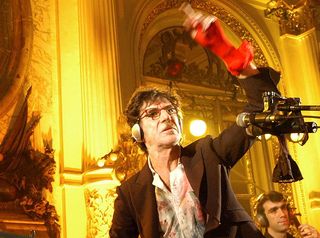 Charly García is a famous singer/songwriter/producer and major figure of rock nacional, with Spanish/Criollo ancestry. He led folk duet Sui Generis, and bands La Máquina de Hacer Pájaros and Serú Girán; he finally started a brilliant solo career in the 1980s and 1990s. In the 1990s, some solo artists continued their successful careers: Charly García was acclaimed for his albums Filosofía Barata and Zapatos de Goma (1990) and La Hija de la Lágrima (1994). Fito Páez's album El Amor Después del Amor (1992) sold more than 600,000 copies, becoming the new best-seller album of Argentine rock. Andrés Calamaro (an ex-Abuelo de la Nada) moved to Spain, and there he formed the band Los Rodríguez with his countryman Ariel Rot and two Spaniards: Julián Infante and Germán Vilela. After the break-up of the band, Calamaro maintained his popularity with his solo albums Alta Suciedad (1997) and Honestidad Brutal (1999). The band Ratones Paranoicos (led by Juan Sebastián Gutiérrez) founded the "rolinga" rock with a musical style based on rhythm & blues -emulating The Rolling Stones-. Although they had released their first LP in the late 1980s, it was not until the 1990s that they reached high levels of popularity with the albums Fieras Lunáticas (1991) and Hecho en Memphis (1993). During the decade, many new bands emerged from the Greater Buenos Aires: hard/heavy rock band Rata Blanca (led by Walter Giardino and Adrián Barilari, both of Italian descent), Attaque 77 with their smash hit Hacelo por mí (1991), Babasónicos (led by Adrián Dargelos), Los Piojos (led by Andrés Ciro), La Renga (led by Gustavo "Chizzo" Napoli), Viejas Locas (led by Cristian "Pity" Álvarez), 2 Minutos, La Portuaria (led by Diego Frenkel, of Ashkenazi Jew descent), and Bersuit Vergarabat (led by Gustavo Cordera). The new millennium has found many of these artists retaining or increasing their popularity. Babasónicos released their albums Jessico (2001), Infame (2003) and Anoche (2005), with an appealing mixture of rock and synth-pop. Bersuit Vergarabat gained massive attention and acclaim with their albums Hijos del Culo (2001), La Argentinidad al Palo (2004, with the title track becoming a smash hit) and Testosterona (2005). Andrés Calamaro returned to Argentina after a few years in Spain and showed his ability to appeal new generations with his albums El Cantante (2004) and El Regreso (2005), especially with a live cumbia version of his song Tuyo siempre. Pop/Romantic Music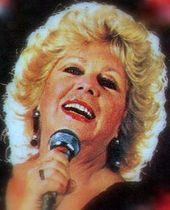 Estela Raval -Palma Ravallo- is a famous singer of bolero and doo wop songs, born in a family of Italian immigrants. The bolero was a genre of romantic music that first appeared in Cuba, and it spread to all Latin America during the 1950s and 1960s. Although most songwriters and performers of the genre are Cuban or Mexican, Argentina contributed to bolero with some singers and songwriters such as Chico Novarro (of Ashkenazi descent), Mario Clavel, Danni Martin, Leo Marini, María Martha Serra Lima, Estela Raval -his parents were Italian- and Roberto Yanés. Pop ballad is connected to bolero in the sense that it is another type of romantic music; it is spread worldwide in most cultures and languages, so it does not need much introduction. Many Argentine artists have performed both boleros and ballads as well, including those mentioned in the previous paragraph. Among the White Argentines who have written and/or performed ballads throughout their careers we may mention: Sergio Denis (of Volga German descent), Roberto Sánchez "Sandro", Alberto Cortez (his father was Spanish), César Pueyrredón, Tormenta, etc. 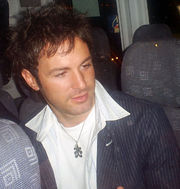 Axel Fernando is another pop singer-songwriter, with Flemish ancestry, born in Rafael Calzada, Greater Buenos Aires. Besides, some artists who started their careers in the rock scene -such as Alejandro Lerner, Sandra Mihanovich (of Ashkenazi and Croatian descent, respectively) and Patricia Sosa- have turned their styles into ballad later. During the last decades, there has been a rising of Latino pop music, with many singers pursuing popularity and sales all through Spanish-speaking America, one of the pioneers of this movement being Sandro in the 1970s. Since then, many White Argentines have contributed to the movement, combining ballads and up-tempo groove songs: in the 1980s, the duet Pimpinela (formed by siblings Joaquín and Lucía Galán, whose parents were Asturian and Leonese) reached high levels of popularity; in the 1990s and 2000s appeared singer-songwriters such as Axel Fernando (of Flemish descent), Marcela Morelo (with Italian ancestry) and Coti Sorokin (of Ashkenazi roots), and pop band Miranda! (formed by Alejandro Sergi Galante, Juliana Gattas, Leandro Fuentes and Nicolás Grimaldi). Other GenresAmong other genres in which White Argentines have stood out is the classical music. Argentine contributions to such genre include Alberto Ginastera and Carlos Guastavino. Other musician who has obtained much success and prestige outside Argentina is Lalo Schifrin (with Ashkenazi Jew ancestry); among his most famous compositions for soundtracks of films and TV series we must mention the Theme from Mission: Impossible TV series and the movies saga. Another orchestra director of Ashkenazi descent is Ben Molar.
EntertainmentMany Argentinians of European descent can be seen and heard daily in Argentina's media, so this section will name many past and present exponents, organized in categories. Latin America's media has frequently been criticized for its concealed racism; countries like Mexico (with a White minority of 16.5%[83]) or Brazil (with 49.7% Whites[84]) are denounced to display as many White people as they can on their screens, as if they were "hiding" their non-White populations.[85] Although this is not the exact same case of Argentina, it is true that few people with non-Caucasian phenotype are shown on soap operas and other TV programs in the country's mass media. File:CarlosBala.jpg Carlos Balá is a comedian -specialized in children's entertainment- with Lebanese ancestry. Although there is a great diversity of origins among the members of Argentina's entertainment industry, in some categories there is a strong presence of Argentines of Ashkenazi Jew descent. Actors: Tincho Zavala, Ulises Dumont, Pepe Soriano, Federico Luppi, Héctor Alterio, Ángel Magaña, Florencio Parravicini, Alfredo Barbieri, Marcos Zucker, Osvaldo Miranda, Maurice Jouvet, Alberto de Mendoza, Luis Brandoni, Alberto Argibay, Claudio García Satur, Luis Sandrini, Juan Carlos Dual, Roberto Carnaghi, Pepe Novoa, Carlos Calvo, Ricardo Darín, Raúl Taibo, Darío Grandinetti, Carlos Olivieri, Julio Chávez, Adrián Suar, Facundo Arana, Mariano Martínez, Gonzalo Heredia, Gastón Pauls, Fabián Vena, Alfredo Casero, Luciano Castro, Matías Cabré, Benjamín Rojas, and many more. Comedians: Alberto Olmedo, Javier Portales, Jorge Porcel, Darío Vittori, Guillermo Francella, Emilio Disi, Alberto Fernández de Rosa, Juan Carlos Mesa, Gianni Lunadei, Tato Bores, Carlos Balá, Enrique Pinti, etc. Actresses: Paulina Singerman, Lydia Lamaison, Niní Marshall, Amelia Bence, Olinda Bozán, Olga Zubarry, Érika Wallner, Luisa Kuliok, Norma Aleandro, Chunchuna Villafañe, Mariana Karr, Dora Baret, Luisina Brando, Leonor Benedetto, Betiana Blum, Soledad Silveyra, Cecilia Roth, Andrea del Boca, Gabriela Toscano, Soledad Villamil, Emilia Mazer, Andrea Tenuta, Laura Novoa, Carina Zampini, Griselda Siciliani, Carla Petersen, Gloria Carrá, Andrea Pietra, Florencia Peña, Celeste Cid, Julieta Díaz, Marcela Kloosterboer, Eleonora Wexler, Marisa Mondino, Romina Gaetani, Luisana Lopilato, Soledad Fantino, Florencia Bertotti, etc.
SportsMany sports that nowadays are very popular in Argentina were introduced by European immigrants -particularly by the British- in the late 18th century and early 19th century. Football is by far the most popular sport in Argentina. It was brought by the British railway businessmen and workers, and it was later embraced with passion by the other collectivities. The first official football match ever played in Argentina took place on 20 June 1867, when the "White Caps" beat the "Red Caps" by 4-0. A look at the list of players -eight by team- shows a collection of British names/surnames. "White Caps": Thomas Hogg, James Hogg, Thomas Smith, William Forrester, James W. Bond, E. Smith, Norman Smith and James Ramsbotham. "Red Caps": Walter Heald, Herbert Barge, Thomas Best, Urban Smith, John Wilmott, R. Ramsay, J. Simpson and William Boschetti.[86] The development of this sport in Argentina was greatly boosted by Scottish teacher Alexander Watson Hutton; he arrived in Argentina in 1882 and -being a supporter of sports as part of education- founded the Buenos Aires English High School in 1884, hiring his countryman William Walters as coach of the school's football team. On 21 February 1893 Watson founded the Argentine Association Football League, the historical antecedent of the Asociación de Fútbol Argentino.[87][88] Watson's son Arnold continued the tradition playing during the amateur age of Argentine football. A non-exhaustive list of all-time Argentine footballers of European/Middle Eastern descent may include: Alfredo DiStefano, Ángel Labruna, Félix Loustau, Amadeo Carrizo, Carlos Babington, Roberto Mouzo, Mario Kempes, Osvaldo Ardiles, Alberto Tarantini, Daniel Bertoni, Ubaldo Fillol, Ricardo Bochini, Claudio Marangoni, Ricardo Gareca, Miguel Brindisi, José Luis Brown, Neri Pumpido, Oscar Ruggeri, Claudio Caniggia, Sergio Goycoechea, Claudio Husaín, Gabriel Batistuta, Carlos Mac Allister, Martín Palermo, Diego Klimowicz, Julio Asad, Javier Zanetti, Walter Samuel, Diego Buonanotte, Lionel Messi, Gonzalo Higuaín, Gabriel Heinze, Javier Mascherano, Fabricio Coloccini, Martín Demichelis, Esteban Cambiasso, Diego Milito, and many others. Current and past coaches with European/Middle Eastern ancestry are: César Menotti, Carlos Bilardo, Miguel Russo, Alfio Basile, Reinaldo Merlo, Carlos Bianchi, Claudio Borghi, José Pekerman, Marcelo Bielsa, Antonio Mohamed, Héctor Cúper (mispelling of Cooper), Carlos Ischia, etc.  Gabriela Sabatini, an ex-tennis player of Italian descent who won the US Open in 1990, and many other tournaments. Tennis was also imported by the British immigrants; in April 1892 they founded the Buenos Aires Lawn Tennis Club. Among the founding members, we find all British surnames: Arthur Herbert, W. Watson, Adrian Penard, C. Thursby, H. Mills and F. Wallace. Soon their example was followed by British immigrants who resided in Rosario; F. Still, T. Knox, W. Birschoyle, M. Leywe and J. Boyles founded the Rosario Lawn Tennis.[88] The first Argentine tennis player of European descent to achieve some international success was Mary Terán de Weiss in the 1940s and 1950s, but tennis was then considered an elite men's sport and her efforts to popularize this activity did not prosper.[89] In the 1970s, Guillermo Vilas -of Spanish descent[90] - won the French Open and the US Open both in 1977, and two Australian Open in 1978 and 1979, and that was when tennis really began to become a popular sport in Argentina. Other important Argentine tennists of European descent are: José Luis Clerc, Martín Jaite, Franco Davín, David Nalbandian, Gastón Gaudio (won the French Open in 2004), Guillermo Coria, Alberto Mancini, José Acasuso, Juan Mónaco, Agustín Calleri, Juan Ignacio Chela, Eduardo Schwank, Horacio Zeballos and Juan Martín del Potro (he won the US Open in 2009), among others. Notable female tennis players are Gabriela Sabatini (who won the US Open in 1990), and Gisela Dulko (recent winner of the 2011 Australian Open Women's doubles). Another sport in which Argentines with European ancestry have stood out is car racing. The greatest exponent was Juan Manuel Fangio (whose parents were both Italian[91]), who won five Formula One World titles in 1951, 1954, 1955, 1956 and 1957; his five-championships record remained unbeaten until 2003, when Michael Schumacher obtained his sixth F1 trophy. Another exponents are Carlos Alberto Reutemann (his grandfather was German Swiss, and his mother was Italian), who reached the second place in the World Drivers' Championship of 1981, and Oscar Larrauri, who won the European F3 championship in 1982 and participated in 21 F1 Grand Prix races. Boxing is another popular sport which was also brought by the British immigrants. The first championship ever organized in Argentina took place in December 1899, and the champion was Jorge Newbery (son of a White American odontologist who migrated after the American Civil War), one of the pioners of boxing, car racing and aviation in the country.[92] A list of Argentine boxers of European descent should include: Luis Ángel Firpo (nicknamed "the wild bull of the pampas", whose father was Italian and his mother was Spanish[93]), Pascual Pérez, Horacio Accavallo, Nicolino Locche (who was nicknamed "the Untouchable" for his defensive style; both his parents were Italian[94]), Oscar Bonavena (nicknamed "Ringo"), Juan Martín Coggi (nicknamed "Látigo"), etc. Volleyball began to be played in Argentina in 1912 by the YMCA, and the Federación del Voley Argentino was founded in 1932. A list of Argentine volleyball players of European descent may include: Daniel Castellani, Hugo Conte, Waldo Kantor and Marcos Milinkovic. Golf was imported by the Scottish immigrants, since Scotland is considered the motherland of modern golf.[95] It was brought to Argentina by Scottish Argentine Valentín Scroggie, who established the nation's first golf course in San Martín, Buenos Aires in 1892.[89]The Argentine Golf Association was founded in 1926 and includes over 43,000 members.[96] Prominent Argentine golfers of European descent are Roberto De Vicenzo (of Italian descent, who won the Golf World Cup in 1953) and Ángel Cabrera, who won the US Open in 2007 and the Augusta Masters in 2009. Basketball began to be played in Argentina in 1912. Few people know that the Argentine team won the first Basketball World Championship in 1950, by beating the US team 64 to 50. In spite of this initial success, basketball lost its popularity until 1984, when the Confederación Argentina de Básquetbol was founded. This proved to be effective to boost the development of this sport, for basketball is now quite popular in the country, and the national team won the Gold medal in Athens 2004 and the Bronze medal in Beijing 2008. Among the past players of European descent we may mention: Oscar Furlong, Leonardo Contarbio (both champions in 1950), Héctor Campana, Marcelo Melanesio, etc. Currently there are several White Argentines playing in the NBA or in the European leagues: Emanuel Ginóbili, Luis Scola, Fabricio Oberto, Walter Herrmann, and Andrés Nocioni. 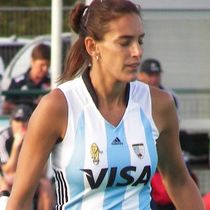 Luciana Aymar is the captain of the hockey national team Las Leonas and current World Champion. She was born in Rosario and has Spanish ancestry. Hockey was another sport imported by the British immigrants in the early 20th Century. It was initially played in the clubs founded by the British citizens until 1908, when the first official matches between Belgrano Athletic, San Isidro Club y Pacific Railways (today San Martín) took place. That same year the Asociación Argentina de Hockey was founded, and its first president was Thomas Bell. In 1909 this Association allowed the formation of female teams. One of the first feminine teams was Belgrano Ladies; they played their first match on 25 August 1909 against St. Catherine's College, winning by 1 to 0.[97] Nowadays the national female team -nicknamed Las Leonas- is the current World Champion, after beating the Netherlands at the final match of the last World Championship, played in Rosario. Almost the entire team is formed by Argentines of European descent: Luciana Aymar, Belén Succi, Mariana Rossi, Claudia Burkart, Carla Rebecchi, Alejandra Gulla, Giselle Kañevsky, Noel Barrionuevo, etc. 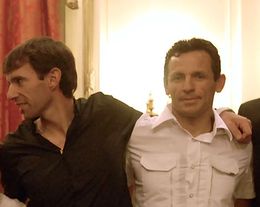 Walter Pérez and Juan Curuchet -of Spanish and French descent, respectively- won the Gold medal for cycling in Beijing 2008. Cycling was introduced by Italian immigrants in Argentina in 1898, when they founded the Club Ciclista Italiano. So, it is not surprise that one of the first South American champions in this sport was an Argentine of Italian descent, Clodomiro Cortoni. Current exponents of this sport in Argentina are Walter Pérez and Juan Curuchet -with Spanish and French ancestry, respectively- winners of the Gold medal in Beijing 2008. Rugby was also brought by British immigrants. The first rugby match ever played in Argentina took place in 1873; the teams were Bancos (Banks) against Ciudad (City). In 1886, the Buenos Aires Football Club and Rosario Athletic Club played the first official match between clubs. On 10 April 1899 it was founded the River Plate Rugby Championship, direct antecedent of the Unión Argentina de Rugby, created to organize local championships; the founding clubs were Belgrano Athletic, Buenos Aires Football Club, Lomas Athletic y Rosario Athletic. Its first president was Leslie Corry Smith, and Lomas Athletic was the first champion that same year. A list of past and current players of European descent may include: Hugo Porta, Agustín Pichot, Felipe Contepomi, Ignacio Corleto, Marcelo Loffreda, Mario Ledesma, etc. Genetic researchWhile the majority of Argentines display primarily Caucasian physical characteristics, recent genetic studies concluded in 2005 have shown that a significant portion of the population has varying degrees of Amerindian and -to a lesser extent- African ancestry. Although these studies were somehow shocking for the Argentine public opinion, this is no strange, for the Americas are one of the regions with more inter-racial admixture in the world. For example, a recent study conducted in the United States in 2007, demonstrated that some White Americans of European descent also have certain degrees of Black African and Amerindian admixture.[98] Furthermore, another genetic study concluded that about 30% of all White Americans, approximately 66 million people, have a median of 2.3% of Black African admixture.[99] In Argentina, the first study on the matter was conducted in 1985; A scientist team from the Facultad de Medicina of University of Buenos Aires analized the blood types of 73,875 doners from the Blood Bank of the Policlínico Ferroviario Central, with the purpose of finding European and Amerindian genetic components. The samples were organized following a map of the country, and the study concluded that "the percentages found in native populación were: European component 81,47%-81,77% and Amerindian component 18,23%-18,57%".[100] Another study of the Amerindian ancestry of Argentines was headed by Argentine geneticist Daniel Corach of the University of Buenos Aires. The results of this study in which DNA from 320 individuals in 9 Argentine provinces was examined showed that 56% of these individuals had at least one Amerindian ancestor.[101] Another study on African ancestry was also conducted by the University of Buenos Aires in the city of La Plata. In this study 4.3% of the 500 study participants were shown to have some degree of African ancestry.[102] Nevertheless, it must be said here that this type of genetic studies -meant only to search for specific lineages in the mtDNA or in the Y-Chromosome, which do not recombine- may be misleading. For example, a person with seven European great-grandparents and only one Amerindian/Mestizo great-grandparent will be included in that 56%, although his/her phenotype will most probably be Caucasian. On the other side, a separate genetic study on genic admixture was conducted by Argentine and French scientists from multiple academic and scientific institutions (CONICET, UBA, Centres D'Anthropologie de Toulouse). This study showed that the average contribution to Argentine ancestry was 79.9% European, 15.8% Amerindian and 4.3% African.[103] Another similar study was conducted in 2006, and its results were also similar. A team led by Michael F. Seldin from the University of California, with members of scientist institutes from Argentina, United States, Sweden and Guatemala, analyzed samples from 94 individuals and concluded that the average genetic estructure of Argentine population contains 78.1% European contribution, 19.4% Amerindian contribution and 2.5% African contribution (using the Bayesian algorithm).[104] A team led by Daniel Corach conducted a new study in 2009, analyzing 246 samples from eight provinces and three different regions of the country. The results were as follows: The analysis of Y-Chromosome DNA revealed a 94.1% of European contribution (a little higher than the 90% of the 2005 study), and only 4.9% and 0.9% of Native American and Black African contribution, respectively. Mitochondrial DNA analysis showed again a great Amerindian contribution by maternal lineage, a 53.7% -though a little lower than the 56% of the 2005 study-, a little higher 44.3% of European contribution, and only 2% African contribution. The study of 24 Autosomal markers also proved a large European contribution of 78.6%, against 17.3% of Ameridian and 4.1% Black African contributions. The samples were compared with three assumed parental populations, and the MDS analysis plot resulting showed that "most of the Argentinean samples clustered with or closest to Europeans, some appeared between Europeans and Native Americans indicating some degree of genetic admixture between these two groups, three samples clustered close to Native Americans, and no Argentinean sampled appeared close to Africans".[105][106] These studies demonstrate explicitly the real impact of the European/Middle Eastern immigration on Argentine ethnography. See alsoTemplate:Col-startTemplate:Col-3
| ||||||||||||||||||||||||||||||||||||||||||||||||||||||||||||||||||||||||||||||
External Links
White Argentines blog (Spanish)
References
- ↑ Edwards, Todd. Argentina. A Global Studies Handbook. pp. 192-94. Santa Barbara, CA: ABC-CLIO, 2008
- ↑ Sociología Argentina. by José Ingenieros. Editorial Losada, 1946. Pages 453, 469, 470.
- ↑ Historical Dictionary of Argentina. London: Scarecrow Press, 1978. pp. 239-40.
- ↑ 4.0 4.1 4.2 4.3 The Joshua Project: Ethnic people groups of Argentina
- ↑ 5.0 5.1 5.2 World Statesmen.org: Argentina
- ↑ 6.0 6.1 6.2 Argentina: People: Ethnic Groups. World Factbook of CIA
- ↑ 7.0 7.1 Argentina: Land of the Vanishing Blacks. by Era Bell Thompson. Ebony Magazine. October 1973.
- ↑ Argentine People by Ethnic Or National Origin: Afro Argentine, List of Argentine Jews, White Argentine, Asian Argentine, Slovene Argentines by Books, LLC. General Books, 2010. ISBN 1157059031, 9781157059035
- ↑ Sociología Argentina. by José Ingenieros. Editorial Losada, 1946. Pages 453, 469, 470.
- ↑ 10.0 10.1 10.2 10.3 Composición Étnica de las Tres Áreas Culturales del Continente Americano al Comienzo del Siglo XXI by Francisco Lizcano Fernández. page 218, UAEM (2005).
- ↑ 11.0 11.1 11.2 11.3 11.4 11.5 11.6 Indigenous or Criollo: The Myth of White Argentina in Tucumán's Calchaquí Valley. by Oscar Chamosa. Pages 77-79. Hispanic American Historical Review. Duke University Press. 2008
- ↑ 12.0 12.1 World Statesmen.org: Bolivia
- ↑ 13.0 13.1 World Statesmen.org: Perú
- ↑ 14.0 14.1 World Statesmen.org: Paraguay
- ↑ 15.0 15.1 Bolivians in Argentina (Spanish)
- ↑ Esperanza Mía; Unos 20 millones de personas que viven en la Argentina tienen algún grado de descendencia italiana, Asteriscos
- ↑ INDEC, 2010 National Census. (Spanish) See temas nuevos.
- ↑ 18.0 18.1 World Fact File. Dorling Kindersley Books Limited, London. This source gives the following percentages: Indo-European 83%, Mestizos 14%, Jewish 2%, Amerindians 1%.
- ↑ Encyclopedia This source also shows an 85%.
- ↑ 20.0 20.1 20.2 Ethnic Groups Worldwide: A Ready Reference Handbook. by David Levinson. Page 313. Greenwood Publishing Group, 1998. ISBN 1573560197
- ↑ Nearly-all White Argentina confronts its troubled racist and religious past. by COHA Director Larry Birns and Research Associate Michael Glenwick. Council on Hemispheric Affairs. 8 November 2007.
- ↑ Luis Vita: Introducción a una teoría de la historia para América Latina. Chapter IV. Editorial Planeta. Buenos Aires, 1992.
- ↑ Nicolás Sánchez Albornoz: La población de América Latina desde los tiempos precolombinos al año 2025, pages 78-80. Alianza Editorial. Madrid, 1994
- ↑ 24.0 24.1 Revisionistas. La Otra Historia de los Argentinos Source: Argentina: de la Conquista a la Independencia. by C. S. Assadourian – C. Beato – J. C. Chiaramonte. Ed. Hyspamérica, Buenos Aires. (1986)
- ↑ Daily Frappe: Hellenic Community of Argentina
- ↑ Argentina 200 Años. Vol. 9 1820-1830. Editor José Alemán. Arte Gráfico Editorial Argentino. Buenos Aires. 2010.
- ↑ Argentina en marcha, Volumen 1. Comisión Nacional de Cooperación Intelectual. 1947. “Para 1826 se admiten 630.000 almas, así repartidas, según Ingenieros: Blancos extranjeros 5.000, Blancos argentinos 8.000, Indios 132.000, Mestizos 400.000, Negros…”
- ↑ Argentina, the Life Story of a Nation. by John W. White, Viking Press (1942), page 124. Cited in World's Great Men of Colour written by Joel Augustus Rogers and John Henrik Clarke, Touchstone (1996), page 191.
- ↑ Buenos Aires Census 1855 (Spanish). UAEM, October 2006.
- ↑ Federaciones Regionales www.feditalia.org.ar
- ↑ CELS - Informe 1998
- ↑ Yale immigration study
- ↑ 33.0 33.1 33.2 Argentina: 1516-1982. From Spanish Colonisation to the Falklands War by David Rock. University of California Press, 1987.
- ↑ Levene, Ricardo. History of Argentina. University of North Carolina Press, 1937.
- ↑ Inmigrantes en Argentina. Censo Argentino de 1914
- ↑ L’Émigration Luxembourgeoise vers l’Argentine (French) by Claude Wey. CDMH (2002). Accessed 25-06-2007.
- ↑ 37.0 37.1 37.2 Migration and Nationality Patterns in Argentina. Source: Dirección Nacional de Migraciones, 1976.
- ↑ Piero on line (biografía). (Spanish)
- ↑ Rodolfo Ranni: "Me hice actor para ganar guita." Diario Clarín (Spanish)
- ↑ Se suicidó Gianni Lunadei. Diario Clarín. (Spanish)
- ↑ Murió César Civita, el gran creador de la editorial Abril. Diario La Nación. (Spanish)
- ↑ politician Francisco Macri. Fundación Kónex. (Spanish)
- ↑ http://www.fruticulturasur.com/fichaSubNota.php?articuloId=250&subnotaId=124 Corazón de chacarero.Fruticultura Sur. (Spanish)
- ↑ http://www.pagina12.com.ar/diario/suplementos/radar/9-4040-2007-08-19.html Mucha madera. Diario Página/12. (Spanish)
- ↑ Argentina Deports a Holocaust-Denying Bishop
- ↑ Oriana Fallaci, Cambio 16, June 1982, Available Online [1] "Si, señora periodista, desciendo de italianos. Mis abuelos eran italianos. Mi abuelo de Génova y mi abuela de Calabria. Vinieron aquí con las oleadas de inmigrantes que se produjeron al comienzo de siglo. Eran obreros pobres, pronto hicieron fortuna." ("Yes, madam reporter, I'm descended from Italians. My grandparents were Italian. My grandfather came from Genoa and my grandmother from Calabria. They came here with the waves of immigrants that occurred at the beginning of the century. They were poor workers, they soon made a fortune.")
- ↑ Ribadumia rinde homenaje a Alfonsín. Diario La Voz de Galicia, 31 March 2009.
- ↑ The Nunca Más (Never Again) CONADEP Report.
- ↑ Inmigración, Cambio Demográfico y Desarrollo Industrial en la Argentina. Alfredo Lattes y Ruth Sautu. Cuaderno Nº 5 del CENEP (1978). Cited in Argentina: 1516-1982 From Spanish Colonisation to the Falklands War by David Rock. University of California Press, 1987. ISBN 0-520-05189-0
- ↑ «A witness narrates how a Bolivian woman was thrown off a train: Tale of a Journey to Xenophobia (Spanish)» by Cristian Alarcón. Diario Página/12, 2 June 2001.
- ↑ «A bullet loaded with racist hatred (Spanish)», Diario Página/12, 9 April 2008.
- ↑ Human Trafficking in Argentina (Spanish).
- ↑ Forced Labor in Argentina (Spanish) Diario Clarín, 5 July 2000.
- ↑ 54.0 54.1 World Statesmen.org: Uruguay.
- ↑ National Household Survey, 2006: Ancestry (Spanish)
- ↑ Napolitanos y porteños, unidos por el acento. Diario La Nación. Template:Es
- ↑ Uruguayan Collectivity website (Spanish)
- ↑ 58.0 58.1 National Institute of Statistics and Censuses (INDEC), 2001.
- ↑ World Statesmen.org: Chile.
- ↑ Estructura Racial. La Universidad de Chile. (Spanish) 28 June 2007.
- ↑ Genetic Epidemiology of Single Gene Defects in Chile; pages 702–706. by Ricardo Cruz-Coke and Rodrigo S. Moreno. Medical Genetics Unit, Hospital Clínico J. J. Aguirre, Universidad de Chile, Santiago. September 1994. Consulted 16 May 2010.
- ↑ Esteva-Fabregat, Book: El mestizaje en lberoamérica "A White majority that exceeds 60% of the Chilean population".
- ↑ Hilda Molina meets her family again in Buenos Aires (Spanish)
- ↑ Recent Migration from Central and Eastern Europe to Argentina, a Special Treatment? (Spanish) by María José Marcogliese. Revista Argentina de Sociología, 2003.
- ↑ Ukrainians, Russians and Armenians, from professionals to security guardians. (Spanish) by Florencia Tateossian. Le Monde Diplomatique, June 2001.
- ↑ Some Romanians make miracles to survive in Buenos Aires. (Spanish) by Evangelina Himitian. La Nación, 20 February 2000.
- ↑ U.S. Census Bureau; Data Set: 2008 American Community Survey 1-Year Estimates; Survey: American Community Survey. Retrieved 2009-11-07
- ↑ Acerca de la Argentina. Inmigración Actual.
- ↑ Geografía de la República Argentina (Spanish). by Paulina Quarleri. Editorial Kapelusz. Printed February 1985.
- ↑ Countries and their Culture: Argentina
- ↑ Carlos Gardel: Síntesis de su vida y trayectoria by Pablo Taboada. Todo Tango (Spanish).
- ↑ Evolution of Tango (Spanish)
- ↑ Begginings of Tango (Spanish). by Jorge Gutman. De Norte a Sur (Noticiero Online). Año 21, Nº 241. September 2001.
- ↑ Ástor Piazzolla Associazione musicale culturale Domenico Sarro (Italian)
- ↑ El Tango y los Vascos.
- ↑ Chango Spasiuk Estación Tierra.
- ↑ Argentina Portal. Culture. Dances. (Spanish)
- ↑ Historia de la Música folclórica de Argentina (Spanish Wikipedia)
- ↑ La historia del rock. Chapter 2. (Spanish)
- ↑ La historia del rock. Chapter 4 (Spanish)
- ↑ La historia del rock. Chapter 21 (Spanish)
- ↑ La historia del rock. Chapter 30 (Spanish)
- ↑ Worldstatesmen.org: Mexico
- ↑ Brazil: resident population, by colour or race, 2008 PNAD
- ↑ Y Tu Black Mama También Newsweek, published 19-06-2003.
- ↑ Argentina 200 Años. Vol. 6 1860-1869. Editor José Alemán. Arte Gráfico Editorial Argentino. Buenos Aires. 2010.
- ↑ History of a Mighty House (Spanish) Diario Clarín, Buenos Aires, 21 February 2003.
- ↑ 88.0 88.1 Argentina 200 Años. Vol. 9 1890-1899. Editor José Alemán. Arte Gráfico Editorial Argentino. Buenos Aires. 2010.
- ↑ 89.0 89.1 Los Deportes y su Historia Template:Es
- ↑ Mi Parentela: Repartición del apellido Vilas
- ↑ F1 Fanatics: Juan Manuel Fangio
- ↑ Larra, Raúl (1975). Jorge Newbery, Buenos Aires: Schapire, page 48.
- ↑ Magazine "Historia de Junín", by Roberto Dimarco. Year 1, Nº 6, May 1969. According to this source, Luis Firpo's father, Agustín Firpo, arrived in Junín in 1887 from Italy, and married a Spaniard woman, Ángela Larroza in 1888. The couple had four children, Luis Firpo being the second child.
- ↑ Locche. El último amague. Diario Clarín, 8 September 2005.
- ↑ Golf History @ ABC-of-Golf
- ↑ Welcome Argentina: Golf
- ↑ Template:Es icon History of the Argentine Hockey Confederation
- ↑ sample of 1387 American Caucasian individuals catalogued in the FBI mtDNA population database, Gonçalves et al. 2007, Sex-biased gene flow in African Americans but not in American Caucasians
- ↑ Afro-European Genetic Admixture in the United States, Frank Sweet
- ↑ Frecuencia de los grupos sanguíneos y análisis de la progresiva disminución del factor Rh negativo en la población Argentina. (1985) Spanish. by E. Quiroga Micheo, Alicia B. Vilaseca, M. C. Bonder, E. R. Quiroga Vergara. 7º Congreso Argentino de Hematología, en Buenos Aires. Revista Medicina (Buenos Aires);48(4):355-60, 1988 Accessed on 14 February 2009.
- ↑ Estructura genética de la Argentina, Impacto de contribuciones genéticas - Ministerio de Educación de Ciencia y Tecnología de la Nación. (Spanish)
- ↑ Almost two million Argentinians have roots in Subsaharan Africa. (Spanish) by Patricio Downes. Clarín 9 June 2006.
- ↑ Mezcla génica en una muestra poblacional de la ciudad de Buenos Aires. Avena, Sergio A., Goicochea, Alicia S., Rey, Jorge et al. (2006). Medicina (Buenos Aires), mar./abr. 2006, vol.66, no.2, p.113-118. ISSN 0025-7680.
- ↑ "Argentine population genetic structure: Large variance in Amerindian contribution" by Michael F. Seldin, et al (2006). American Journal of Physical Anthropology, Volume 132, Issue 3, Pages 455-462. Published Online: 18 December 2006.
- ↑ Inferring Continental Ancestry of Argentineans from Autosomal, Y-Chromosomal and Mitochondrial DNA by Daniel Corach, Oscar Lao, Cecilia Bobillo, Kristiaan Van Der Gaag, Sofia Zuniga, Mark Vermeulen, Kate Van Duijn, Miriam Goedbloed, Peter M. Vallone, Walther Parson, Peter De Knijff, Manfred Kayser. First published on-line: 15 Dec 2009. Annals of Human Genetics; Volume 74, Issue 1, pages 65–76, January 2010. DOI: 10.1111/j.1469-1809.2009.00556.x © 2009 Blackwell Publishing Ltd/University College London.
- ↑ How Argentina Became White. Magazine Discover: Science, Technology and the Future.
